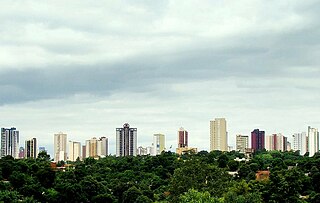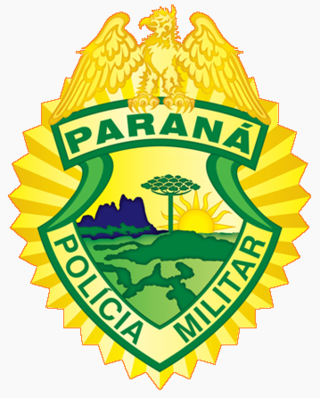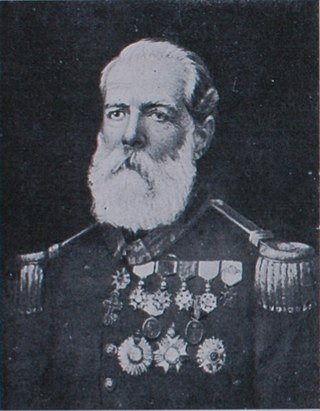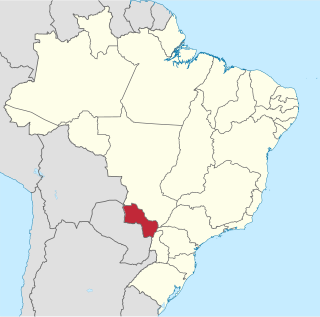
Paraná is one of the 26 states of Brazil, in the south of the country. It is bordered in the north by São Paulo state, in the east by the Atlantic Ocean, in the south by Santa Catarina state and the province of Misiones, Argentina, and in the west by Mato Grosso do Sul and Paraguay, with the Paraná River as its western boundary. It is subdivided into 399 municipalities, and its capital is the city of Curitiba. Other major cities are Londrina, Maringá, Ponta Grossa, Cascavel, São José dos Pinhais and Foz do Iguaçu. The state is home to 5.4% of the Brazilian population and generates 6.2% of the Brazilian GDP.
The Triple Frontier is a tri-border area along the junction of Argentina, Brazil and Paraguay, where the Iguazú and Paraná rivers converge. Near the confluence are the cities of Puerto Iguazú (Argentina), Foz do Iguaçu (Brazil) and Ciudad del Este (Paraguay). This area is near Iguazú Falls and the Itaipu hydroelectric plant.

Foz do Iguaçu is the Brazilian city on the border of Iguaçu Falls. The city is the 7th largest in the state of Paraná. The city's population is approximately 258,000. It is approximately 650 km (400 mi) west of the capital of the state, Curitiba, being the westernmost city in that state.

The Brazilian Highway System is a network of trunk roads administered by the Ministry of Transport of Brazil. It is constructed, managed and maintained by the National Department of Transport Infrastructure (DNIT), federal agency linked to the Ministry of Infrastructure, and the public works departments of state governments.

The Battle of Tuyutí was a Paraguayan offensive in the Paraguayan War targeting the Triple Alliance encampment of Tuyutí. It is considered to be the bloodiest battle ever in South America. The result of the battle was an Allied victory, which added to the Paraguayan troubles after the loss of its fleet in the Battle of Riachuelo.
Portuguese is the third most spoken language of the Americas, and the second most spoken language in South America. It is the sole official language of Brazil and is a co-official language of several regional organizations, notably Mercosul, UNASUL, ACTO, CELAC, the Rio Group, and ALADI.

The Military Police are reserve and ancillary forces of the Brazilian Army, and part of the System of Public Security and Brazilian Social Protection. Its members are called Military's States.
The primary mission of PMPR is the ostensible and preventive policing for the maintenance of public order in the State of Paraná.

The Platine War was fought between the Argentine Confederation and an alliance consisting of the Empire of Brazil, Uruguay, and the Argentine provinces of Entre Ríos and Corrientes, with the participation of the Republic of Paraguay as Brazil's co-belligerent and ally. The war was part of a decades-long dispute between Argentina and Brazil for influence over Uruguay and Paraguay, and hegemony over the Platine region. The conflict took place in Uruguay and northeastern Argentina, and on the Río de la Plata. Uruguay's internal troubles, including the longrunning Uruguayan Civil War, were heavily influential factors leading to the Platine War.

Events in the year 1974 in Brazil.

The Brazil–Paraguay border runs from Foz do Iguaçu, Paraná, to Corumbá, Mato Grosso do Sul. It crosses a variety of terrains, going from large urban areas by inhospitable deserts and wetlands. It starts within the framework of the three borders, between Foz do Iguaçu and President Franco and ends in the triple border with Bolivia, near the Paraguayan city of Bahía Negra. On the border between Brazil and Paraguay, lies the Itaipu Hydroelectric Power Plant, which is one of the largest hydroelectric plants in the world in terms of annual energy generation.

The Mbyá, also called Mbyá Guaraní, are a branch of the Guaraní people who live in South America, across a wide territory that ranges through Paraguay, Brazil, Argentina, and Uruguay.

Events in the year 2020 in Brazil.

The steam frigate Amazonas was a frigate-type warship that served in the Imperial Brazilian Navy and, for a short period, in the Brazilian Navy after the Proclamation of the Republic in 1889. The frigate was built in the Thomas Wilson Sons & Co. shipyards in Birkenhead and Liverpool, England; it was launched in August 1851. The purchase of this vessel was part of an effort by the Empire of Brazil to obtain more modern ships, due to the country's lag with some foreign powers. Amazonas was commissioned in 1852.
Anti-Brazilian sentiment refers to negative feelings, fear, discrimination and hatred towards Brazil, the Brazilian variant of Portuguese language, Brazilian people or the Brazilian culture.

Hermenegildo de Albuquerque Portocarrero, Baron of Forte de Coimbra was a Brazilian Marshal and Baron. He was known for being the primary commander of the Invasion of Corumbá during the Mato Grosso Campaign of the Paraguayan War.

Voluntários da Pátria, was the name given to the volunteer military units created on 7 January 1865 by decree of the Empire of Brazil to fight in the Paraguayan War with which the imperial government sought to strengthen the Imperial Brazilian Army.

The Invasion of Rio Grande do Sul began on June 10, 1865 when about 7,500 soldiers under the command of General Antonio de la Cruz Estigarribia invaded the village of São Borja near Brazil's border with Argentina. About 3,000 men commanded by major Pedro Duarte stayed on the other side of the Uruguay River to accompany the advance of the main column. The Paraguayans always advanced along the river without major damage, with the exception of a confrontation on the Butuí River where a Paraguayan battalion had been defeated, until they reached Uruguaiana, where a two-month siege made them surrender unconditionally on September 18. The main objective of Paraguayan president Francisco Solano López to invade Rio Grande do Sul was to force a peace treaty favorable to the Paraguayans with the Empire of Brazil. The action took place in the second phase of the Paraguayan War, known as the Corrientes campaign.

The historiography of the Paraguayan War has undergone profound changes since the outbreak of the conflict. During and after the war, the historiography of the countries involved, for many, was limited to explaining its causes as due only to the expansionist and excessive ambition of Paraguayan president Francisco Solano López. However, since the beginning of the war there was a strong movement pointing out the conflict as the responsibility of the Empire of Brazil and of Argentina led by president Bartolomé Mitre. In this reading, Argentine and Uruguayan federalist intellectuals, such as Juan Bautista Alberdi, are brazen. In Uruguay, the criticism of Luis Alberto de Herrera stood out.

The Federal Territory of Ponta Porã was composed of seven municipalities dismembered from the south of Mato Grosso: Bela Vista, Dourados, Maracaju, Miranda, Nioaque, Ponta Porã and Porto Murtinho. All of them were border areas and some of them comprised the extremity of Brazil's political-administrative possessions. The administrative unit was established in 1944 between the Paraná and Paraguay, rivers with important fluvial circulation in the southern region of Mato Grosso. Throughout its existence, the Federal Territory of Ponta Porã was administered by three governors: Colonel Ramiro Noronha, Major José Guiomard dos Santos and José Alves de Albuquerque.

Augusto João Manuel Leverger, Baron of Melgaço, nicknamed "Cuiabá's Breton" was a French-Brazilian admiral, writer, historian, geographer and several times President of the province of Mato Grosso in the Empire of Brazil. He was a key figure of Mato Grosso's literature production during his time.

















